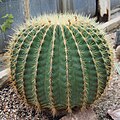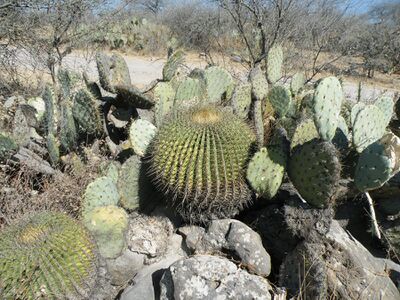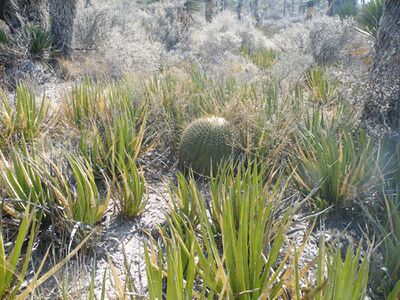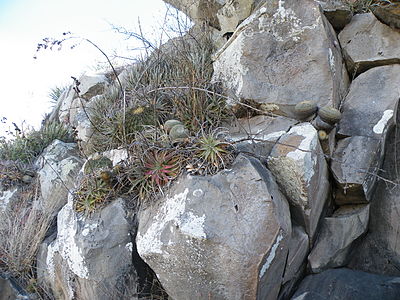Biology:Ferocactus histrix
| Ferocactus histrix | |
|---|---|
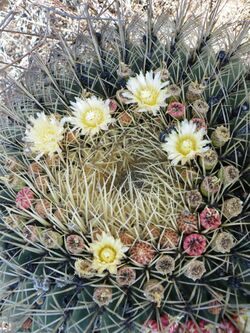
| |
| Scientific classification | |
| Kingdom: | Plantae |
| Clade: | Tracheophytes |
| Clade: | Angiosperms |
| Clade: | Eudicots |
| Order: | Caryophyllales |
| Family: | Cactaceae |
| Subfamily: | Cactoideae |
| Genus: | Ferocactus |
| Species: | F. histrix
|
| Binomial name | |
| Ferocactus histrix (DC.) G.E. Linds. 1955
| |
| Synonyms | |
|
List
| |
Ferocactus histrix, also known as Acitrón barrel cactus (Biznaga barril de acitrón) is a species of Ferocactus native to central Mexico.[2] It is a large barrel cactus that can be commonly found throughout all the Central Mexican matorral. It produces an edible fruit appreciated for its sour taste.
Description
This cactus grows as an unbranched spherical globe, and can reach more than 1 meter (3.3 ft) in height after several years. Mature plants can have their stem divided in up to 25 to 40 ribs.[3] The epidermis is blue-green in mature plants. As in other cacti species, when the apical meristem is damaged, the plant produces new shoots from the areoles close to the tip of the stem.[4][3] Spines are light yellow and turn brown as they age. There are one to four protruding central spines that are straight or slightly curve, flattened or angular and up to 9 centimeters long. The six to nine radial spines are slightly curved, round and up to 8 centimeters long.
It produces yellow medium-sized flowers from early to late spring and usually the fruits are mature by summer. It flowers when the plant is 10 years or older, though in cultivation they can flower earlier. After flowering, the Mexican cactus produces small, edible fruits that are often enjoyed by birds and other desert animals. Known for its ability to adapt to arid desert environments. It has a deep root system that allows it to absorb water from deep in the soil. This cactus also has a thick, waxy outer layer that helps prevent water loss through evaporation. This slow-growing cactus initially grows as a globular and then columnar cactus.[5]
Distribution and habitat
This cactus can be found (from east to west) in Hidalgo, Querétaro, Guanajuato, San Luis Potosí, Aguascalientes, Jalisco, Zacatecas and Durango which makes it one of the barrel cacti with some of the largest distribution. It grows in xeric shrublands and volcanic slopes at elevations of 1200 and 2600 meters.[6]
Ferocactus histrix growing in habitat with Mammillaria muehlenpfordtii in San Luis de la Paz in Guanajuato, Mexico
Taxonomy
Ferocactus histrix was first described as Echinocactus histrix in 1828 by Augustin-Pyrame de Candolle. Its specific epithet, "histrix," is derived from Latin and means "hedgehog," referring to the species' thorns. In 1955, George Edmund Lindsay reclassified the species into the genus Ferocactus. Other names for this species are cactus de barril de caramelo, cactus de caramelo, cactus de electrodo and cactus de barril mexicano.
References
- ↑ Group), Succulent Plants Specialist (2009-11-16). "The IUCN Red List of Threatened Species". IUCN Red List of Threatened Species. https://www.iucnredlist.org/species/152548/121539168. Retrieved 2024-01-17.
- ↑ "Ferocactus histrix in Tropicos". http://www.tropicos.org/Name/100336725.
- ↑ 3.0 3.1 del Castillo, Rafael F.; Trujillo, Sonia (1991). "Ethnobotany of Ferocactus histrix and echinocactus platyacanthus (Cactaceae) in the Semiarid Central Mexico: Past, Present and Future". Economic Botany 45 (4): 495–502. doi:10.1007/BF02930713. ISSN 0013-0001.
- ↑ Anon. n.d. "Biznaga barril de acitron - Ferocactus histrix." Planet Desert. Retrieved (https://planetdesert.com/products/biznaga-barril-de-acitron-ferocactus-histrix?pr_prod_strat=use_description&pr_rec_id=f349fb3fa&pr_rec_pid=8068113957107&pr_ref_pid=7997529817331&pr_seq=uniform).
- ↑ Anon. n.d. "Biznaga barril de acitron - Ferocactus histrix." Planet Desert. Retrieved (https://planetdesert.com/products/biznaga-barril-de-acitron-ferocactus-histrix?pr_prod_strat=use_description&pr_rec_id=f349fb3fa&pr_rec_pid=8068113957107&pr_ref_pid=7997529817331&pr_seq=uniform).
- ↑ De Medio Ambiente Y Recursos Naturales, Secretaría. n.d. "Conoce 8 especies endémicas mexicanas, orgullo nacional." gob.mx. Retrieved (https://www.gob.mx/semarnat/articulos/conoce-10-especies-endemicas-mexicanas-orgullo-nacional?idiom=es).
External links
Wikidata ☰ Q145195 entry
 |




